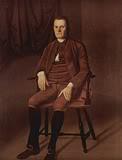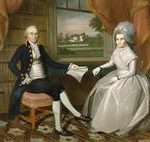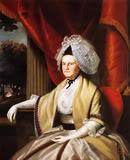Wife of Declaration of Independence Signer Lyman Hall
Dr. Lyman Hall
Mary Osborn was born on August 8, 1736, at Fairfield, Connecticut, the daughter of Samuel and Hannah Osborn. Lyman Hall, son of John Hall and Mary Street Hall, was born April 12, 1724, in Wallingford, Connecticut, to a well-connected family. Lyman’s paternal grandfather, the Honorable John Hall, was a member of the Governor’s Council and a Justice of Connecticut’s Supreme Court. His maternal grandfather was the Reverend Samuel Street, Wallingford’s first pastor.
Lyman went to Yale College and studied theology, graduating in 1747 at the age of 23. He also studied theology with his uncle, the Reverend Samuel Hall in Cheshire, Connecticut. He was called to pastor in 1749 in Stratfield Parish, now Bridgeport, Connecticut. Certain parishioners opposed him, and he was dismissed in 1751 after allegations were made against his moral character. For the next two years he continued to preach, substituting in vacant pulpits, while he also began to study medicine and teach. He went back to Yale, this time to the medical school.
In 1752, Lyman married Abigail Burr of Fairfield, Connecticut, on May 20, 1752, but she died on July 8, 1753, at the age of 24. They had no children. Lyman graduated from Yale again in 1754; settled in his native town of Wallingford, and began his practice of medicine.
Lyman Hall married Mary Osborn of Fairfield, Connecticut, on July 29, 1757.
In 1757, the Halls migrated to South Carolina and established himself as a physician at Dorchester, a community settled by Congregationalist migrants from Dorchester, Massachusetts, who had arrived decades earlier. When these settlers moved south to Georgia’s coastal Midway District in St. John’s Parish, the Halls went with them. This area provided more land and a healthier climate – the inland plantations skirted malarial swamps.
In 1758, the colonists finished their emigration and founded the town of Sunbury, Georgia, which evolved into the thriving seaport-hub of the surrounding slave-based, rice-indigo economy. The town was laid out on high, beautiful land facing the Midway River. Dr. Hall bought two of the nicest lots and built a summer residence there, as did many other planters.
Dr. Hall became a leading citizen of Sunbury. His medical practice prospered, and he bought land in Burke County in 1760, and built a rice plantation a few miles out of town, called Hall’s Knoll, and continued practicing medicine, which became one of the more successful offices in the area, not only for his patients in town, but he also made house calls in the countryside. He enjoyed visiting his patients, and had the bedside manner of sympathizing friend.
Lyman and Mary Hall had one son, John, born in 1764, and they became members of the Midway Congregational Church. Dr. Hall was still a young man, in his early thirties, six feet tall, well proportioned, cultured and educated, had polite manners, and was of a well rounded character. His public spirit and thoughtful views made him popular among the inhabitants of St. John’s Parish.
When the trouble with Britain erupted in the mid-1760s, St. John’s Parish stood apart in its opposition from virtually all the rest of the colony, except for another cluster of Revolutionaries at Savannah. When the differences between England and her American colonies were discussed, and separation between them was seriously considered, Lyman Hall’s sympathies from the first were with the colonists.
The Colony of Georgia refused to join the Continental Association, whose purpose it was to enforce the boycott of British goods. Georgia was the youngest, most remote, and most sparsely settled colony. Also the poorest, it felt less the impact of British economic restrictions. The Loyalist ruling aristocracy of Georgia regarded the tiny band of Revolutionaries with contempt, and resisted their every move.
In Georgia, more so than in sister colonies, there was great division in sentiment on the political questions within the community. Parliament had awarded great sums of money and other generous bounties in the colony’s recent settlement years, the royal party was active and strong, and the Governor was energetic in upholding the fortunes of his royal master. The governor was able to delay Georgia representation in the Continental Congress, so there were no Georgia delegates appointed to the 1774 Continental Congress in Philadelphia.
As the Revolution approached, St. John’s Parish, in which Sunbury was located, became a center of anti-British sentiment in Georgia. In July 1774, a Revolutionary Convention met in Savannah, where Dr. Hall represented St. John’s Parish. He was appalled by the poor representation of the parishes as a whole, and very disappointed with the lukewarm measures adopted by the convention, which elected not to send any representatives to the First Continental Congress. Hall dejectedly returned to St. John’s Parish.
There was another convention in Savannah in January 1775; Dr. Hall represented St. John’s Parish once again. When the delegates voted for more delays and negotiations with the King and failed to get Georgia moving toward joining the other colonies, Hall and others from St. John’s Parish next sought to contract with a group in South Carolina, whereby they could deal and trade and bypass Savannah’s control and increase the political pressure on the Loyalists. This was rejected by the Carolinians.
In March 1775, Dr. Hall called a meeting of patriotic citizens in St. John’s Parish, who unanimously elected him to represent them in the Continental Congress – not the colony of Georgia, only St. John’s Parish. On May 13, 1775, Dr. Hall arrived in Philadelphia, and was unanimously admitted as a delegate. Since he did not represent the whole colony, but only one parish, his right to vote was to be determined later.
Fortunately, the Georgia Convention finally voted to join the Congress on July 15, 1775, and appointed five members to Congress, three of whom actually attended: George Walton, Button Gwinnett, and Dr. Lyman Hall. In the following session of 1776, Dr. Hall spoke out most forcefully for independence from Great Britain. On July 4, 1776, at age 52, he voted for the Declaration of Independence, and signed the parchment copy with most of the other delegates on August 2. Hall served in the Congress until 1780.
![]()
Signature of Dr. Lyman Hall
On the Declaration of Independence
In 1777, the British invaded Georgia and captured Savannah. In January 1779, Sunbury was captured, and Dr. Hall was accused of high treason. Mary and their son John escaped and joined Lyman in Philadelphia, just before British troops ravaged the Georgia coast. For nearly two years the Halls remained absent, and they suffered great financial loss from the British confiscation of their home, plantation and slaves. In the process, Hall’s Knoll and their Sunbury residence were destroyed.
After the British evacuation of Savannah in 1782, Dr. Lyman Hall and his family returned to Georgia, and made their home in Savannah, where Dr. Hall resumed practicing his profession and began to rebuild his plantation. But his leadership was sought once again, and in January 1783, he was elected Governor of Georgia.
Hall agreed to serve as Governor for only one year, so the energies of his administration as governor were chiefly directed to establishment of land offices and sale of confiscated property; to the arrangement of the public debt; to the rewarding of officers and soldiers with bounty warrants for services rendered; to working toward the accommodation of differences and preventing disturbances with Florida; to the establishment of courts and schools; and most importantly, with the consummation of treaties of cession and friendship with Cherokee and Creek Indians.
While he was Governor, Dr. Hall also championed the founding of a state university that would focus on religious education to increase the moral virtue of the state’s citizens. This led to the founding of the University of Georgia in 1785. That same year he sold his plantation, Hall’s Knoll.
At the expiration of his term as governor, Dr. Hall resumed his medical practice in Savannah, and held no further public office. He evidently prospered in the next few years; in 1790, he purchased Shell Bluff rice plantation on a bluff overlooking the Savannah River in Burke County, and the family moved there.
Dr. Lyman Hall died at his plantation on October 19, 1790 at the age of 66, and was buried in a substantial brick vault on his land, where his wife and son were also later interred.
There his remains rested until 1848, when he was brought to Augusta, Georgia, and buried beneath a magnificent monument erected in front of the courthouse in Augusta. Called The Signers’ Monument, it is a fifty-foot granite obelisk, which honors the three Georgia Signers of the Declaration of Independence: Lyman Hall, Button Gwinnett, and George Walton (who is also buried there).
Mary Osborn Hall died November, 18, 1793, at Shell Bluff Plantation. Their only child, John Hall, died childless shortly thereafter, so there are no direct descendants of this esteemed Patriot.
SOURCES
Lyman Hall
Lyman Hall: Georgia
Wikipedia: Lyman Hall
Lyman Hall (1724-1784)
Lyman Hall 1724 – 1784
Profiles of Georgia’s Signers
Georgia Signer of the Declaration of Independence







So interesting. Stories were told to us as we have common grandfathers as my grandmother was Emma Hall, and her father John Hall and his father a John Hall as well. I just joined ancestry to chase the same info in more specifics.
We are coming to Jacksonville in February so plan to travel to Hall’s Knoll and Savannah’s to view the area.
Thank you for this most concise write up I have seen so far. Any other info that you could share would be appreciated,
Best regards,
Shirley Shea Okamoto
Grandaughter of Emma Hall Harvey
My grandmother told me years ago that Lyman Hall is my 6th great grandfather. However, John Hall had no children. I don’t understand why she shared that with me. So sad.